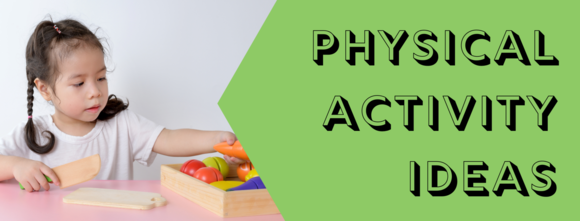 Welcome to 2022 and with it some ideas to encourage healthy eating in your setting. Good healthy habits, started early in life, set your children up on the right path and can help to prevent obesity in the future. Children will often try foods that they maybe wouldn't otherwise eat during a food activity or if they see someone else eating them. So, provide healthy "cooking" activities and try to sit, eat and be seen to enjoy healthy food alongside the children.
You can help provide a healthy eating environment by:
- Making mealtimes relaxed and comfortable
- Sitting and eating with the children
- Being positive about the healthy foods the children are eating
- Gently encouraging fussy eaters to try new foods
- Setting a good example/being a positive role model with the foods you eat (and not eating a bag of crisps or drinking a can of fizzy drink).
 Think about the risks of children choking on food - it's more common than you may think. Tragically, a child dies in the UK every month from choking and hundreds more require hospital treatment. It can happen quickly, and it can happen to anyone/anywhere.
The Early Years Foundation Stage Framework requires settings to ensure children are kept safe and recognise that for children under five, choking prevention is an important part of this. Updates to the Early Years Foundation Stage Framework reflect this, with 3.29 making clear that children should be supervised whilst eating, and a footnote added to paragraph 3.46 directing providers to guidance on food preparation.
Remember:
- Make sure the food is suitably prepared and served for babies and children under 5
- Ensure young children and babies are alert and seated safely upright
- Think about size, shape and texture of food and the child that is going to eat it
- Remove any stones and pips from fruit before serving
- Cut small round food (like grapes and cherry tomatoes into thin strips)
- Supervise children whilst feeding/eating at all times - sit with them
- Encourage children to chew well and take their time
- If possible, sit down with them and be a good role model
- Know how to respond to a choking incident and how to resuscitate a child
- Never force a baby or child to feed or eat
Here are some posters developed by the Food Standards agency for you to display in your food preparation and feeding areas
Choking hazards poster
Choking hazards table
Check out the government's Food safety page where you can find out more information about food safety in early years settings.
 Ideas to share...
Make a rainbow salad - can be made with fruit and/or vegetables (beware of any allergies)
Select fruits and or vegetable from each of the colour groups and help the child to shred or chop the food (if old enough) into small pieces and then arrange either on a plate in patches of colours or in layers in a clear drinks cup. By eating a variety of different coloured fruit and vegetables children are eating a range of the daily different vitamins and minerals.
Greens: Lettuces, green peppers, grapes, kiwi, spinach, kale, brussels sprouts, broccoli, asparagus, courgette, celery
Reds: Tomatoes, red peppers, watermelon, red pepper, grapefruit, pomegranate, raspberries, cherries, papaya, cranberries, strawberries
Oranges: Carrots, orange peppers, various squashes, pumpkin, cantaloupe, pineapple, citrus fruits, peaches, mango
Whites: Onions, garlic, parsnips, cauliflower, yellow squash
Purples: Aubergine, red cabbage, red onion, beetroot, grapes, cherries, blueberries, blackberries, prunes.
 By making your own rainbow salad - chopping, mixing, holding spoons etc. you are encouraging both fine and gross motor movements and helping to develop the children's muscles associated with moving their limbs, hands and fingers and developing their finer muscular movements. Other ideas can be to ask your children to pretend to be their favourite type of fruit or vegetable and make their shapes such as a round orange that rolls around or a long stick of celery that stretches up to the sky.
|